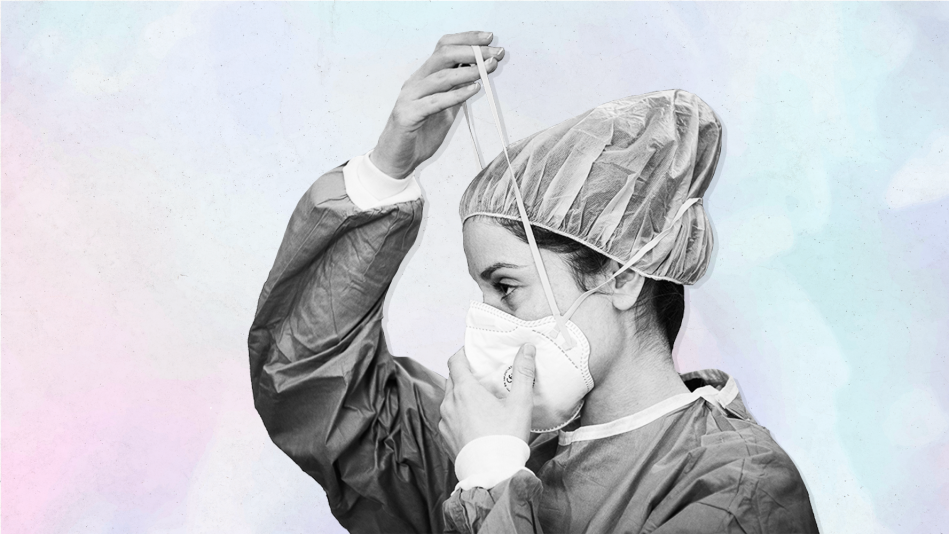What I've Learned as a Doctor Treating COVID-19 Patients in Isolation
The coronavirus pandemic has meant hospitalized patients must navigate their most difficult days alone.

Photo: Temi Oyelola/Getty Images
As a neurosurgical chief resident at Duke University Hospital, I met Beth in the middle of February during pre-COVID life. She and her husband had just braved a tornado to drive to the hospital; she was scheduled for surgery the next day to have a brain tumor removed. He left to grab their stuff and check on her two college-aged daughters, making sure they were traveling safely in the storm. As she waited for her husband to return, we chatted. She told me that she worked at a farmer's market, and that one day, when she was trying to text, she realized she couldn't see well on the left side, a symptom that ultimately led to her diagnosis of brain cancer.
Beth's surgery went well, but the following day, as she was preparing to go home, she started to complain of a headache. It turned out to be brain swelling, which was difficult to treat and required her to spend several more days in the hospital. On the day she left, she was as cheerful and resilient as when she'd arrived.
A few weeks later, she returned to the clinic with a chocolate peanut butter cake she had baked for everyone who had cared for her while she was in the hospital. We all fell even more in love with her as we sat in the breakroom passing around pieces of cake on paper towels.
But the next night, Beth returned to the hospital for a much less happy reason: Her brain swelling had suddenly gotten much worse—and this time, she was no longer responsive. We took her in for emergency surgery to treat the swelling. We collectively decided we no longer liked cake.
After the operation, she was slow to wake back up. We had tough, tearful conversations with her husband, daughters, and mother, who stayed faithfully by her side. And they weren't the only ones. Every time we went to find one of them in the waiting room, they were surrounded by a gaggle of church friends, neighbors, and other family members. Slowly, Beth started to come back to us, responding to little cues. We were delighted when she wiggled her toes on command. And when she opened her eyes and told her daughter she loved her, we all breathed a sigh of relief.
Given how bad the brain swelling was, the medical team decided she would need to stay in the hospital for close monitoring during much of her radiation and chemotherapy treatment. As long as she was making progress, her husband and family were okay with this plan; they were always at her side. One day, when getting her to eat was a challenge, they remembered how much she liked Wendy's chili, so that meal quickly became an afternoon staple.
My job as a neurosurgical chief resident often goes this way: I meet patients and their families before surgery, and in a few moments, I try to understand who they are. The surgery is typically planned during a visit with an attending doctor (my boss) beforehand, but sometimes happens on more of an emergency basis. I help in the operating room and then see patients daily in the hospital to check on their progress until they go home. Most patients leave the hospital a day or two after surgery. What feels like a whirlwind for the patient can be brief and routine for us as resident doctors. It doesn't mean it's not important—it definitely is—but with large lists of patients to see and medical records to complete, we have to balance efficiency and compassion.
When the news about the coronavirus hit, we weren't yet seeing cases here in North Carolina. It was all about preparation, and the hospital began to implement necessary precautions for everyone's safety. They were especially protective of high-risk patients like Beth. One Saturday evening, we received an email: Visitors would no longer be allowed at the hospital, except in very specific cases of imminently dying patients, pediatric cases, or women in labor.
The next morning, I saw Beth's husband. He had heard about the new policy, and asked if there were any exceptions. He said he would quarantine in the room with her if it meant he could stay by her side. I asked, but, unfortunately, an exemption could not be granted. He was crushed—and so was I.
What happened next was much bigger than the two of us. It was a collaborative response that I've now witnessed with many patients, family members, and healthcare providers in reaction to this unprecedented situation of visitor restrictions due to COVID. I promised him that I'd come see Beth every day and call him to let him know how she was doing. Her nurse quickly added that maybe all of the video cameras we used to monitor patients with seizures could be used to communicate with family members stuck at home. This conversation led to an initiative in the intensive care unit to use our computer stations to virtually connect with family members.
Read the original story here: What I've Learned as a Doctor Treating Coronavirus Patients Who Aren't Allowed Visitors



